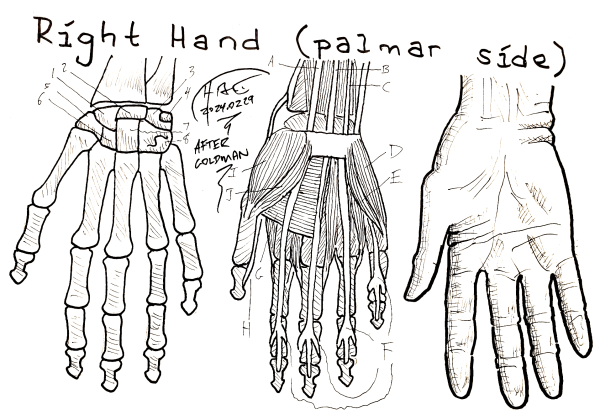
Again from Goldman. Drawing every day.
-the Centaur
Words, Art & Science by Anthony Francis

Again from Goldman. Drawing every day.
-the Centaur
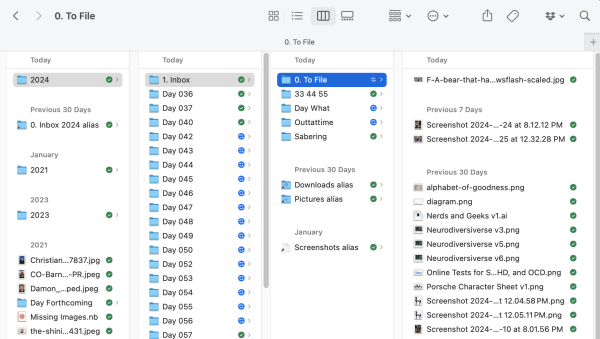
SO! I am still chasing down places in my life where I have been “letting things pile up” and, as a consequence, causing myself stress down the road when I have to clean it up. And I found yet another one - tied in with my drawing / blogging projects.
I have a tremendous complexity tolerance compared to some of the people I’ve worked with, to the point that I’ve been repeatedly told that I need to focus the information that I’m presenting in a way that more clearly gets to the point.
But when piled complexity passes even my tolerance level, I get EXTREMELY stressed out. I knew I got stressed from time to time, but as part of examining my behavior and mental states looking for triggers - inspired by Devon Price’s Unmasking Autism - I zeroed in on dealing with the piles as the actual problem.
Online files aren’t quite as bad - I think it is the actual physical piles that become intimidating, though I think any task too big for my brain to wrap around all the things that need to be done, like editing a novel, may cause the same problem - and so, as part of working on Drawing Every Day, I decided to clean up those files.
I already had a good system for this, broken down by day and year … which I was not using. Now, in theory, you could throw all these files into a bin and forget about it, or even delete them, but I hope to use my files for a deep learning project, so it will likely benefit me to categorize the files as I go.
But, as part of trying to “get ahead”, I’d been working fast, letting the files pile up. This, I realized, easily could turn into one of those aversive pile situations, so I dug in today and fixed it. As a result, I didn’t get to all the things I wanted to get to over lunch.

For decades I’ve had the habit eat-read-write, and my weekend lunches and brunches are a particularly precious writing / coding / thinking time for me. I gets a sad when I don’t get to fully use that time, as today where I spent time on cleanup and I have remote meetings with my friends and my small press in the afternoon.
But this work has to get done sometime, or it won’t get done. And for this project, my collected files for Drawing Every Day will become useless if they aren’t organized - not just for the hypothetical deep learning project, but also for me, in reviewing my own work purely artistically to decide where I should put my learning effort next.
For me, I’ve had to learn not to be so hard on myself. By many metrics, I get a lot done; by other metrics, I feel unproductive, disorganized, even outright lazy. But the truth is that there’s a lot of groundwork that needs to be put in to make progress.
I’ve been trying to teach myself game development since, hell, the early 2000’s. Most of the time, other than a little side effort on interactive fiction, I didn’t make any progress at this, because it was always more important to code for work, to draw, and then, after I got my drawing laptop stolen and got a novel contract not too far apart, to write.
After I got laid off, I decided, “now’s the time! I’m going to do games!” Of course, that didn’t happen: I and my research collaborators had a major paper in flight, a workshop to plan, and I had to launch a consulting business - all while still writing. While I did read up on game development, and spent a lot of time thinking about it, no coding got done.
But most of your learning is on the plateau: you don’t appear to be making progress, but you’re building the tools you’ll need to progress when you’re ready. So all the work I’ve been doing on consulting and for the research projects is looping back around, and I’ve used what I learned to start not one but three tiny games projects.
It’s not likely that I’ll release any of these - at this point, I am just futzing around trying to teach myself - but it is striking to me how much we can accomplish if we put in continual effort over a long period of time and don’t give up.
I can’t tell you how many people over the years have told me “well, if you haven’t seen progress on something in six months, you should quit” or “if you haven’t worked on something in two years, you should get rid of it”. I mean, what? This is terrible advice.
If you want to be productive, don’t take advice from unproductive people. Productive writers and artists typically have apprenticeships lasting anywhere from a year to a decade. It can take years of work to become an overnight success.
And many of the steps leading to that success are unglamorous, tiresome, unsexy scutwork, like organizing your files so you know what you have, or reviewing them so you can decide the next learning project you need to take on to master a skill.
The work has to be done sometime. Best get on with it.
-the Centaur
Pictured: the Drawing Every Day project files, post-cleanup and organization. There’s still a bin of files that need to be filed, but they’re a very contained bin, compared to the mess there was before. Also, a picture of this essay being composed, at my precious Saturday lunch-read-and-write.

Reviewing my past art, I noticed that mis-aligned and mis-spaced eyes, and generally poorly placed and scaled faces, were a problem. So I tried to focus on that problem this time, and ... it didn't turn out bad.
As usual, it's Porsche the Centaur, via a Midjourney character sheet, again. Though her hair is WAY too huge ... I guess I really do romanticize big hair.

Drawing every day.
-the Centaur
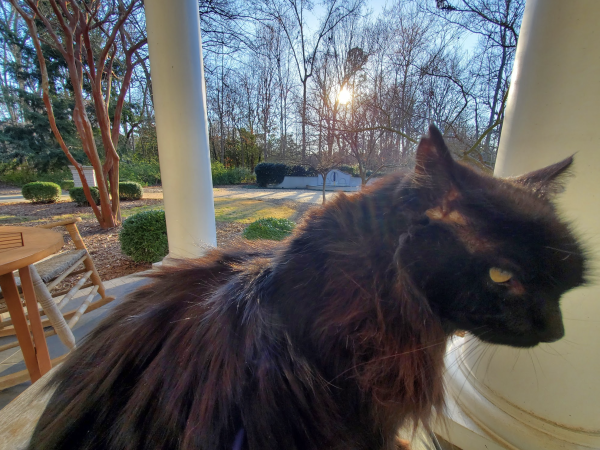
He sure looks upset. Are you upset? I think you’re upset.
You’re still hanging around for scritchies though.
Maybe not so upset.
Who can tell.
-the Centaur
Pictured: a cat, looking very upset. Well. Maybe not so upset.
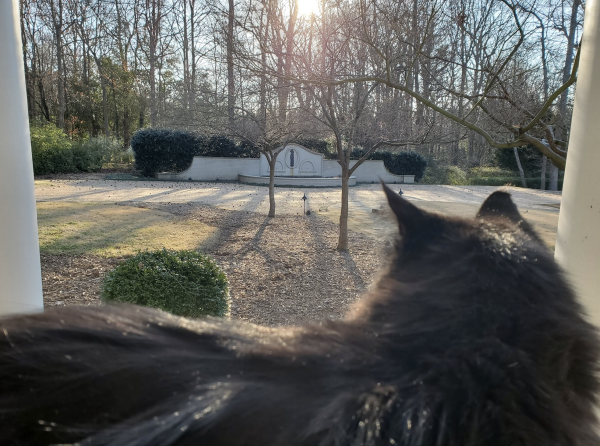
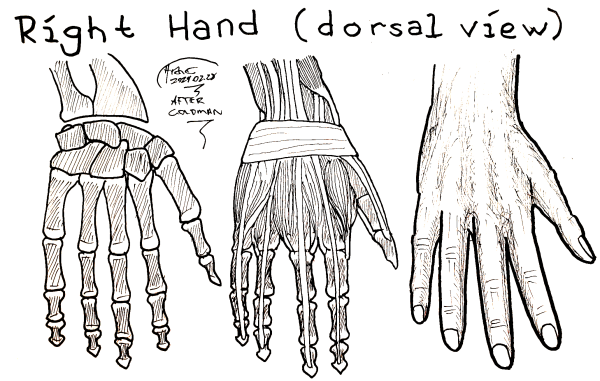
More Goldman studies, putting the hand back together from the bones, tendons, muscles and skin.
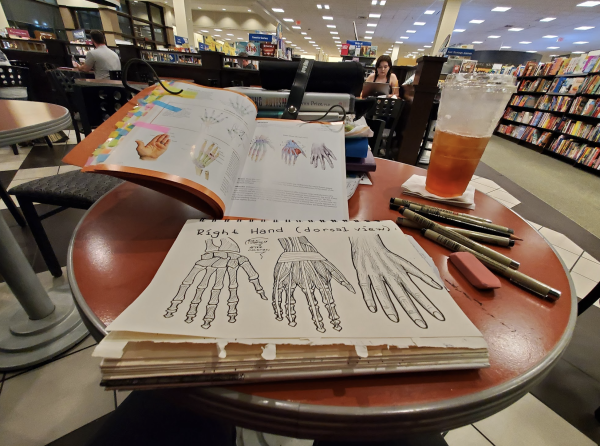
This methodical process really seems to be helping me build confidence in my art. Yay!
Drawing every day, more or less.
-the Centaur
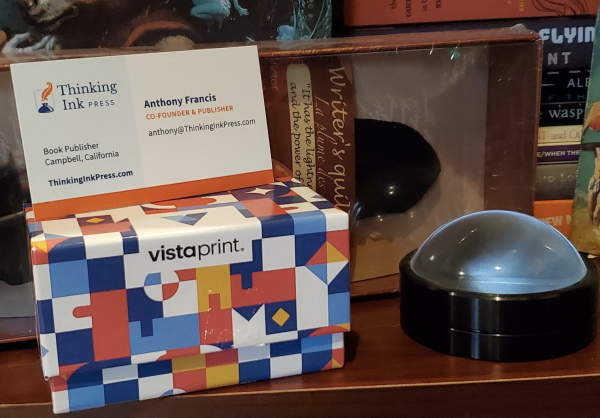
So! Thinking Ink Press has been around for aaaalmost a decade now, and we seem to be getting some of our proverbial shit together. Presented as a case in point: professionally designed business cards, done by the graphic designer who updated our already very nice logo which we had designed in-house. There are several subtle features of the logo we wanted to preserve that our cofounder Nathan Vargas had woven into the design, and she worked with us to update it while retaining the core features of Nathan’s original.
Then we had her do business cards, and again she iterated with us to get it right. We just test-printed the first run and drop-shipped it to the team individually (since that was cheaper than shipping it to a central site and re-shipping it) and they look awesome.
Slowly, we do seem to be getting it together. Hard to believe sometimes, but apparently dedication, hard work and not fucking giving up will slowly add to something.
Here’s hoping the people who read our books will agree!
-the Centaur
Pictured: the card, atop a box of the cards.

Following up recent posts about things taking longer than you think.
Trying to do cleanup, laundry, and organization before starting my next task? I predicted “a few minutes”. It took a bleeding hour.
I need hours at a time to get coding done. I need focus.
I don’t need to be interrupted by rescuing a cat from the rain!
But you have to anyway. Argh!
Time tracking (I use Clockify), if done pretty rigorously, can really dispel some illusions about how much work we can get done in a short amount of time - and, conversely, about all we did do in that block of time that didn’t feel productive.
Case in point: I’ve already done 6 hours of stuff today that wasn’t on my agenda for today. And all this stuff “needed” to get done - at least for a normal, human interpretation of the word “need”.
I feel the need to qualify that as I’ve been through cognitive behavior therapy (CBT), an evidence-based approach to dealing with stress, and while it is wonderful, it does have some intellectually dishonest components, like throwing out “need” language.
I get it — there are things we think we “need” that we really don’t — but some of the therapists I worked with pushed that to an extreme that didn’t make sense. Sure, you don’t “need” to breathe, but if you don’t, you’ll pass out and/or die.
So, yes, the stuff “needed” to get done in the normal, human sense of the word. I mean, sure, you could throw out all your clothes instead of doing laundry and order new ones online, but that would neither be efficient nor sustainable.
But more directly, some of that was organizing my files for my current active projects, some of which I did indeed need to pull up and organize in order to take the next steps on those projects.
Funny how our busy-beaver selves sometimes try to convince ourselves that certain things don’t “need” to be done … but if we don’t do them, we won’t get anything done.
Or the cat will have to stay in the rain.
-the Centaur
P.S. And this post took another 15-30 minutes, as I came back to it later.
Pictured: the bottom coming out. It was short, but it was a hell of a rainstorm.
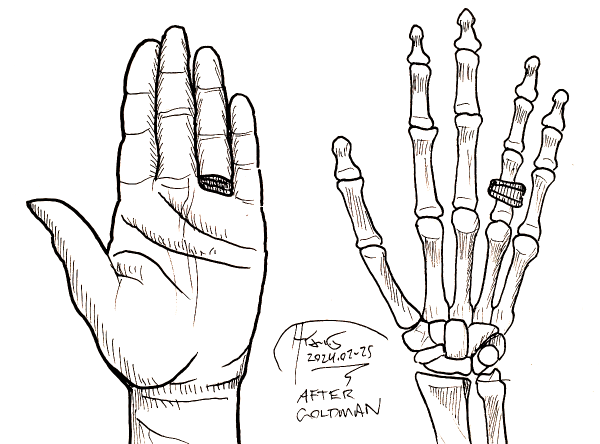
More Goldman studies, featuring an early prototype of the One Ring that just made the wearer's flesh invisible, an effect Sauron is reported to have described as "too creepy, even for me."
Drawing on average every day, posting every day that I can.
-the Centaur
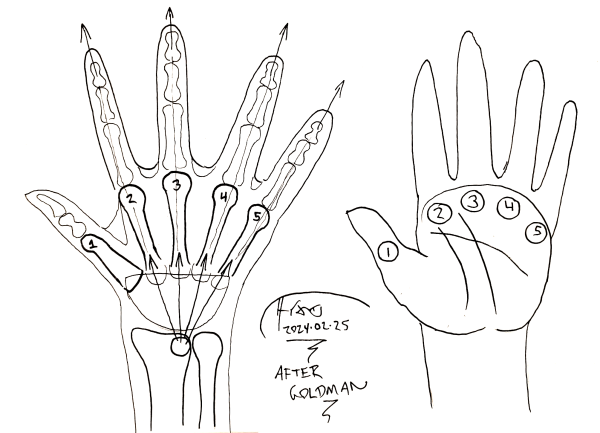
Again showing how they radiate from the wrist.
Drawing every day.
-the Centaur

... these things take time.
Now that I’m an independent consultant, I have to track my hours - and if you work with a lot of collaborators on a lot of projects like I do, it doesn’t do you much good to only track your billable hours for your clients, because you need to know how much time you spend on time tracking, taxes, your research, conference organization, writing, doing the fricking laundry, and so on.
So, when I decided to start being hard on myself with cleaning up messes as-I-go so I won’t get stressed out when they all start to pile up, I didn’t stop time tracking. And I found that some tasks that I thought took half an hour (blogging every day) took something more like an hour, and some that I thought took only ten minutes (going through the latest bills and such) also took half an hour to an hour.
We’re not realistic about time. We can’t be, not just as humans, but as agents: in an uncertain world where we don’t know how much things will cost, planning CANNOT be performed correctly unless we consistently UNDER-estimate the cost or time that plans will take - what’s called an “admissible heuristic” in artificial intelligence planning language. Overestimation leads us to avoid choices that could be the right answers.
So we “need” to lie to ourselves, a little bit, about how hard things are.
But it still sucks when we find out that they are pretty fricking hard.
-the Centaur
P.S. This post, and some of the associated research and image harvesting, I expected to take 5 minutes. It took about fifteen. GO figure. Pictured: the "readings" shelves, back from the days when to get a bunch of papers on something you had to go to the library and photocopy them, or buy a big old book called "Readings in X" and hope it was current enough and comprehensive enough to have the articles you needed - or to attend the conferences themselves and hope you found the gold among all the rocks.

SO! Working on The Neurodiversiverse led me to writing again, and writing those stories led me to Devon Price’s Unmasking Autism, which in turn led me to realize I have undiagnosed social anxiety disorder with autistic / ADHD / OCD tendencies.
“Unmasking” is an important process that autistic people can elect to undergo where they stop putting so much effort into conforming to neurotypical expectations - “masking” - and start building a life which is built around how their bodies and minds work.
While unmasking can be risky, with a real threat to life, limb or livelihood even for autistics who are privileged, much less people from other disadvantaged groups, it often comes with great benefits - not just to mental health, but physical well being.
But, if you know one autistic person, then you know one autistic person, and advice that helps one autistic person may not help another. So I found some of Price’s advice to be helpful - even as I had to subvert it for my own use case.
In particular, one thing many autistic people who are stressed out by trying to keep up with neurotypical expectations of cleanliness is to stop worrying so much about it. The thinking goes, if it stresses you out to put clothes in a hamper, who cares? Just change clothes in the same place and let them pile until you take them to the laundry.
But what I realized is that I was unconsciously doing this - letting mail, dishes, or laundry (cleaned or dirty) pile up until I had enough spoons to deal with it. My thinking went, if I am doing my work and keeping the lights on, who cares if the mail piles up for a few weeks? I’ll get to it when I deliver what I am responsible for.
But what I realized was, this was hurting me. The bigger the piles were, the more intimidating they became, and the more I put off dealing with them - a vicious cycle. But when I finally was forced to deal with one of the piles, I found myself infinitely MORE stressed than I was taking care of things a step at a time.
A habit I had adopted to deal with one aspect of my undiagnosed neurodivergence - a possibly autistic avoidance of organizing chores in favor of focus on work that kept the lights on - was really messing with another aspect of my mental makeup: an obsessive-compulsive need to have everything organized and in its place.
I went through this before with the library where I’m typing this; it used to be so disorganized that I didn’t want to spend time here, but once it was organized, I loved spending time here. So I am rewarded to expend this effort.
So, in an effort to go easier on myself, I have started being harder on myself about piles. Not letting them grow; dealing with them right away, before they become intimidating. The hope is, if I can keep the space around me organized, maybe the stress I feel about dealing with piles will fade away, and I can really focus on the work I want to.
Let’s see how it goes.
-the CentaurPictured: The afternoon lunch-and-read habit, featuring Unmasking Autism.
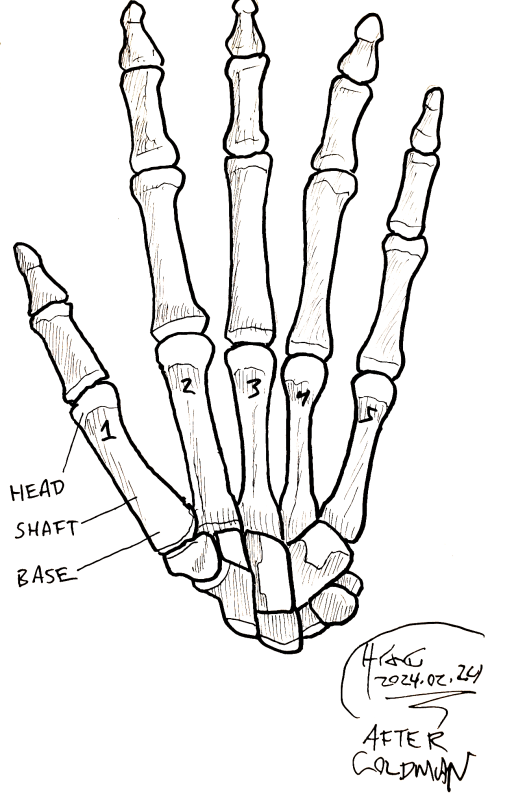
Breakdown of the metacarpals; the finger ones radiate from a point at the base of the carpals.
Drawing (more or less) every day, posting every day that I can.
-the Centaur
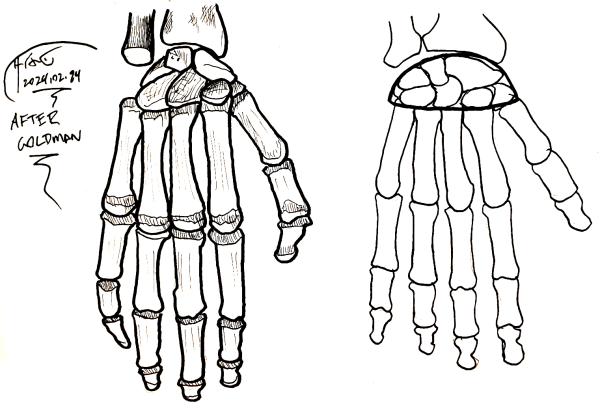
So, the root bones of the hand - the carpals - are mostly stuck together and can be thought of as a half-moon shape. But it is the act of dis-assembling the hand, breaking it into its component parts, identifying them, and grouping them, that really enables this act of re-integration. From 2 days ago:
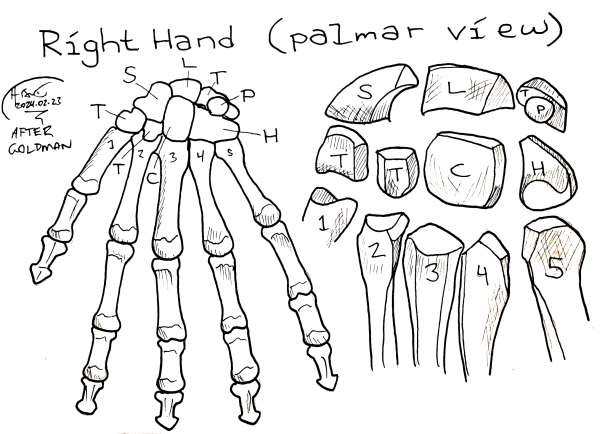
It's all starting to come together. Drawing (on average) every day.
-the Centaur

So, my “blog buffer” enabled me to spend most of Tuesday focusing on work and writing. (And even doing a little game playing in Infinite Craft.) When I crashed out, I remembered, “oh, I need to blog” … but checked my blogroll, and saw that the buffer had posted for me. So I instead got to turn in early and get some much-needed sleep.
I’m going to need to catch up today and tomorrow, of course, trying to get four posts in two days so I have time to chill out over the weekend and focus on editing the rough draft of Spectral Iron and the returning stories on The Neurodiversiverse. But it sure is easier to keep a commitment when you plan ahead to make sure you fulfill that commitment than it is to commit without thought and hope that muddling through with “hard work and discipline” will somehow manage the job that should be done by actual thinking.
-the Centaur
Pictured: breakfast at Nose Dive, one of the many places in downtown Greenville where it is impossible to eat breakfast on Sunday morning without an hour wait - unless you reserve ahead.
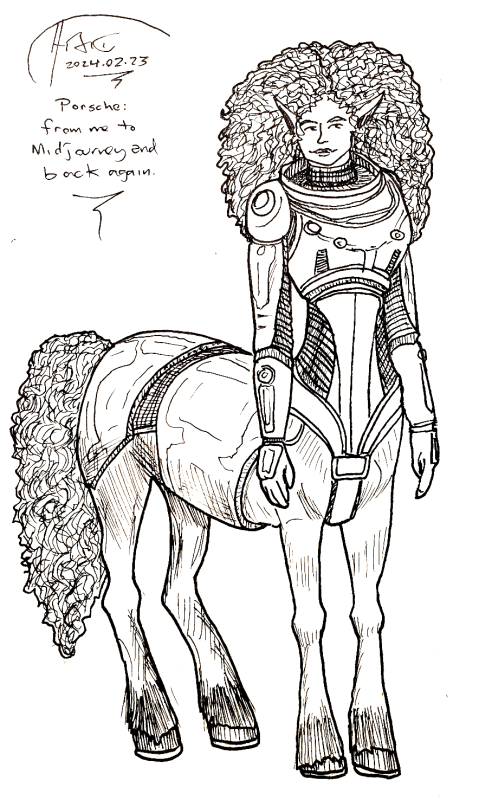
Another drawing of Porsche from a generative AI character sheet (I think this one was from ChatGPT+DALL-E, which seems to be a bit better than Midjourney at taking art direction and creating centaurs). I modified the face to more closely match Porsche, whose ears are located more closely to a normal human's ears.

I've started to build up a buffer, like I am for the Blogging Every Day series, by trying to do two drawings at every sitting. I can't manage to draw for an hour and a half every single day, but if I do it most days, then I slowly creep ahead, and can put more effort and thought into each drawing.

According to my spreadsheet, I'm now about six drawings ahead, drawing-wise, and two posts ahead, posting-wise. Maybe I can take some time to, you know, write about these characters now.
Drawing (more or less) every day.
-the Centaur
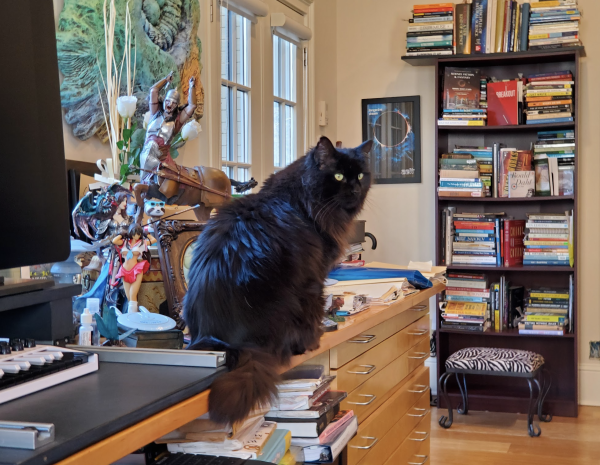
So I’ve developed a new tool for story analysis that my co-editor on The Neurodiversiverse, Liza Olmsted, called “your seven-part story test,” and it fits in one long sentence: “Who wants what, why can’t they get it, what do they do about it, how does it turn out, why does that matter to them, and what does that mean for the reader?”
This six-part test is an adaptation of Dwight Swain’s story question “Who wants what and why can’t they get it?” as well as Vorwald and Wolff’s pithier but less useful “What happens?”, called the Major Dramatic Question (MDQ) in their book “How to Tell a Story.”
Now, V&Q unpack their MDQ into the broader questions “What does my character want? What action do they take to get it? What keeps them from getting it? Who succeeds or fails?”. Like many writing coaches who have their own language for similar ideas, I think both Swain and V&W are tackling the “Major Dramatic Question”, just from different angles - but “how it turns out” is a key question not encapsulated in Swain’s version, and I think it helps us understand what is going on - or should be going on - in a story.
Ultimately, I think a story is an engaging and surprising case, in the case-based reasoning (CBR) sense. For those not familiar with CBR, it’s a reasoning technique back from the days of symbolic artificial intelligence (AI), pioneered by Janet Kolodner, the leader of the AI lab where I was trained (and my original thesis advisor). A case, in the traditional sense, is a labeled experience, which is marked by what problem is being solved, what solution was applied, how it turned out, what lesson it taught, and how we might remember it.
Well, in the age of content-addressable memories and vector databases, we worry less about labeling cases so we can remember them, as the content itself can help us find relevant cases. However, it remains important to analyze our experiences so we can better understand what happened, what we did, how it turned out, and what lessons that taught (or should have taught) us. And the last two are related, but different: what happened are the bare facts, but the same bare facts can have different meanings to different people that experience them - or to different observers, watching from the outside.
Think of a woman in an abusive marriage. What she wants is a peaceful life; why she can’t get it is a husband who’s a Navy SEAL with PTSD. Let’s say what she does about it is try to kill him, and how it turns out is that she gets away with it. But what does that matter to her, and what does that mean for us (the writer, the editor, the publisher, and the author)?
Well, that same outcome could matter in different ways. Perhaps our heroine gets to build a new happy life away from a man who abused her - or perhaps our heroine is now living a life of regret, with a child that resents her and feelings of guilt about killing a man who couldn’t cope with his wartime trauma and needed her help. Because the truth of it is, no-one should have to put up with domestic violence - but a small percentage of people who struggle with PTSD end up acting out, and need help to deal with their trauma.
There’s no right answer here - a skilled author could present a spectrum of situations in which most of us would say either “get them help” or “girl, get out”. But if the author shows our heroine murdering their husband and getting away with it, the story is implicitly endorsing murder as a solution for domestic problems. Conversely, if the author shows the heroine forgiving violence in an attempt to get the husband help, the story is implicitly endorsing women enduring domestic abuse. Not only is there no right answer here, there’s no good answer here - which might lead you as an author to question the whole setup.
That’s why it’s really important to step back and think about what you as an author are endorsing in your story - and whether you’re comfortable with that message. Despite what some writing teachers will tell you, you’re not the god of your story: you’re playing in a playground of your own making, but the materials from which that playground is fashioned - people, places, events, actions, reactions, and emotions - are all drawn from the very real world in which we live, and stories by their nature communicate messages about that real world to those who read them, even if the events in the story are purely fictional.
(This principle of authorial endorsement extends to the editor, publisher, and even the reader as well. There were many good stories submitted to The Neurodiversiverse that we chose to reject because of their implicit message - for example, we wanted our anthology to be empowering, so we didn’t select some powerful stories in which the character’s neurodiversity helped them communicate with aliens, but didn’t help the horrible situation that they were in; these stories might be a great choice for a horror anthology, however).
But the point can get lost if you start asking a lot of unconnected questions about your story. That’s why I like the idea of the unified MDQ, and I like the expression of that in Dwight Swain’s three-part question “Who wants what, and why can’t they get it?” But that three-part version is not enough, and expanding that question into a single phrase that incorporates the important elements of action, outcome, impact and meaning turns it into my seven-part test: “Who wants what, why can’t they get it, what do they do about it, how does it turn out, why does that matter to them, and what does that mean for the reader?”
The rewards for thinking through these questions are great. Thinking about how the story turns out matters to the protagonist creates options for tweaking the ending (or the material leading up to it) for greater resonance; and thinking about what meaning the story delivers for the reader creates opportunities to weave that message through the whole story. The seven-part story test can help us create stronger, more impactful, and more meaningful stories that make more sense and feel more satisfying.
So, to unpack the seven-part test further:
Overall, I’ve already got a lot of good mileage out of these questions in the new series of stories that I’m writing (which I’m variously calling “The Porsche Xenobiology Stories” or “Tales of Failaka” depending on which planet I’m writing on this week). By asking these questions, I’ve been able to reformulate my endings to focus not just on the outcomes of the character’s actions, but how it matters to them, which makes the endings more satisfying; and also to focus on what it means, which has enabled me to make the stories more cohesive, as well as inspiring ideas for new stories.
“Who wants what, why can’t they get it, what do they do about it, how does it turn out, why does it matter to them, and what does that mean for the reader?” It’s a short, seven-part story test, easily compressible into a sentence that can be used to interrogate your story, and it’s been very useful for me; I hope it is useful for you too.
-the Centaur
Pictured: Loki, and in the background, the reading "pile" for a writing book that I'm working on called "The Rules Disease." Yes, it has filled most of a bookshelf by this point - there's a lot of writing on writing.

And, it turns out, there's a handy mnemonic to remember all those bones: Sally Left The Party To Take Cathy Home. If only I remembered the names of the bones that the letters SLTPTTCH corresponded to ...
Drawing every day.
-the Centaur
Apparently it's scaphoid, lunate, triquetrum, pisiform, trapezium, trapezoid, capitate, and hamate ...
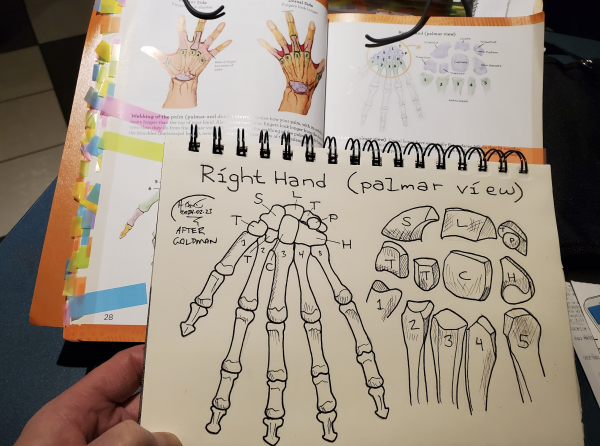
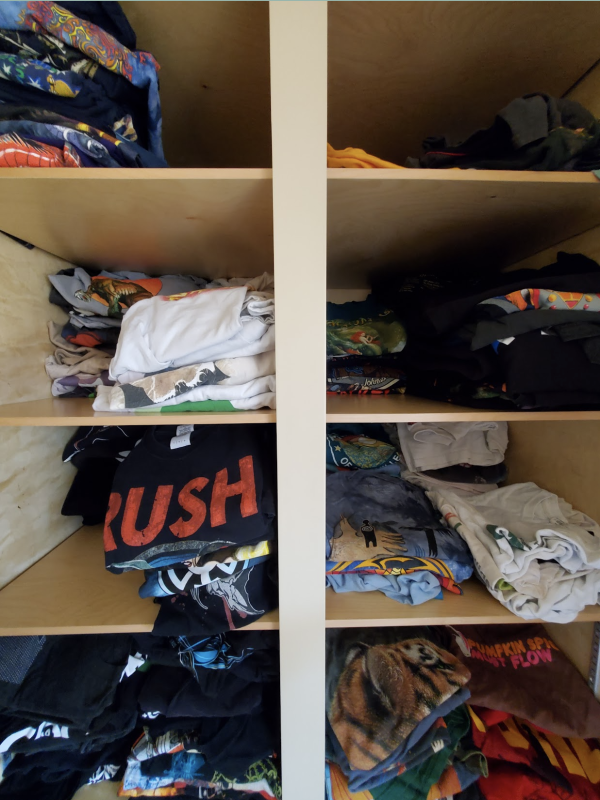
So I’m confused: I know I’m a bit weird, but I stopped to think about the supposedly "weird" way that I do things and I genuinely do not understand how “normal” people manage it.
So what you see above is my collection of genre T-shirts. I love genre T-shirts and wear them most of the year - as my shirt in the summer, and as my undershirt in the winter.
I used to think this collection was excessive; most of the other people I know don’t have near as many themed shirts, just a collection of normal clothes.
But I started pulling on that thread (ha, ha) a bit and it just didn’t make sense to me.
SO what you see there is something like 300-500 shirts in my closet. I didn’t count them all, but I estimated by counting a few piles and extrapolating by the number of piles.
But if you wear a shirt every day, this is only enough shirts for roughly a year. And I know from *ahem* considerable experience now that even rarely worn old T-shirts, which are typically made from better fabric than modern T-shirts, last at most 20-30 years.
Now, between science fiction conventions, travel, and very occasional clothes shopping, I purchase maaaaybe 10 or so T-shirts per year, which I thought was an excessive habit.
But over 20-30 years, this adds up again to 300 shirts … so by the time that I’ve worn out all the shirts in my collection, I will have purchased enough shirts to fill it up again.
Now the conundrum: most of the people I know don’t buy a lot of t-shirts, and they don’t have a huge library of clothes. So how are they not wearing through all their clothes all the time?
Now, I know my wife buys a lot of clothes (mostly at Goodwill), but she’s power tool girl, and her clothes rapidly get worn out or covered with paint and later used as rags.
But the friends that I know who DON’T seem to buy that many clothes ALSO have a similar strategy. One of them called it “the circle of shirts”: First it’s a nice T-shirt, then it’s an undershirt, then it’s a gym shirt, then it’s a yard shirt, then it’s a rag.
But if people don’t have a huge library of shirts, and they’re not buying a buttload t-shirts, why aren’t they going around in tattered rags all the time?
What do “normal” people do? Go to Target and buy white T-shirts every week, as the six pairs of shirts and undies that they have rapidly disintegrate from the rotation?
I genuinely don't get it.
-the Centaur
Pictured: my collection of T-shirts, some of which do eventually get retired from wear.
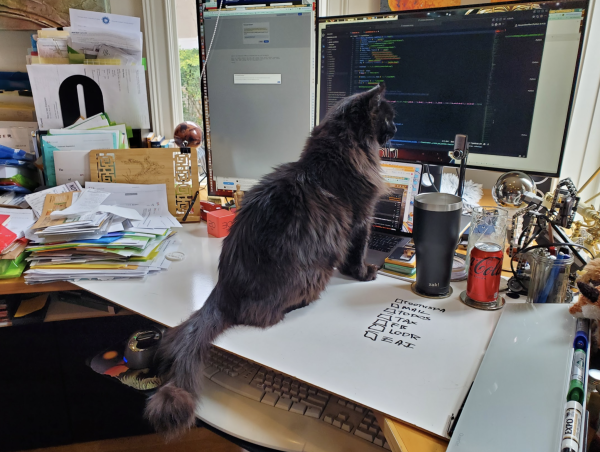
Only six months have passed since I last worked on the Embodied AI Workshop website, and now the code will not compile in a horrible mess of broken dependencies. I have tried two or three ways of installing it, including in place, from scratch, and even on a Parallels instance of Ubuntu in case macos was the problem. Nothing works. As a last-gasp effort, I plan on creating an AWS instance, in case Apple Silicon itself is the problem (I suspect it is, as one of the libraries has no Apple Silicon binary packages, and the instructions to recompile from source are roughly five years out of date).
But software is a mess. Occasionally you get something that's awesome (like Python - or Rust! Installation of the Bevy game engine was smooth as a dream) but more often things explode in a mess of unresolvable dependencies, and you're stuck between Apple locking everything down, Windows becoming spyware, and Linux not running anything you want at all.
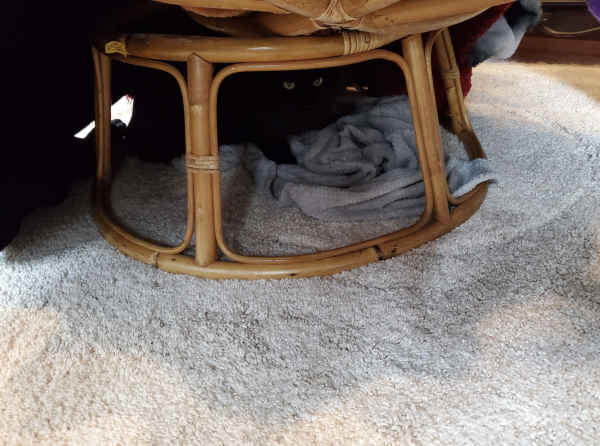
I'd weep for the future, but I'm too busy hiding from it.
-the Centaur
Pictured: My software consultant, deciding discretion is the better part of valor. Actually, up top Loki has seen the installer for the rock border in the French Quarter, and below he is hiding from him.
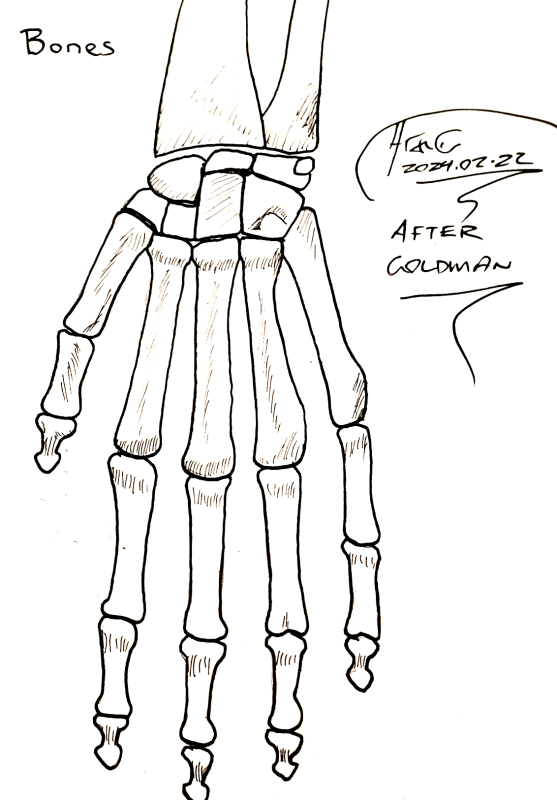
More Goldman. I love what I'm learning here, but I think I'm going to need to start adding in an occasional drawing of something else to mix it up.
Drawing every day.
-the Centaur